Introduction The veterinary activities in the Central Rift region went on successfully, during the month of March, 2008
Introduction
The veterinary activities in the Central Rift region went on successfully, during the month of March, 2008. The veterinary team conducted investigations for mange infestation in Cheetahs and Thompson’s gazelles and livestock in Masai Mara. There was also an investigation on reported deaths of wildlife in Soysambu ranch in Nakuru. Clinical cases attended to include those of elephant injury cases in Mara. Black rhino ear-notching in Lake Nakuru National park was successfully carried out during the month. There was also elephant de-collaring exercise that took place in Ewaso-Nyiro in Narok district, a male elephant was de-collared and released. An elephant calf was also rescued from a dam in Lemek area and joined the mother. It has been a very successful month with all the reported cases attended to in good time.
Treatments of elephants at Governors camp Masai Mara
There were reported cases of injured elephants by the Governors lodge manager in Masai Mara, one of the cases involved an adult female elephant with a one-year old calf. It had been treated before but it had no good response to the earlier treatment so we decided to repeat the treatment and observe its response with time.
The animal was suffering from a deep severe wound on its left front limb just above the carpal joint, it was unable to walk properly and preferred lying down most of the time. We found it lying at the river bank with its calf and attempt to drive it away from the river so that it could be anaesthetized for treatment did not achieve much because it was not willing to move away from the source of water due to pain while moving.
Chemical immobilization and capture
The elephant was then captured through darting using 16mgs of etorphine hydrochloride combined with 1500 i.u hyaluronidase. We used Dan-inject dart-gun propelled from about 10 meters away from the animal, the dart landed on the right thigh. It took about 5 minutes to become recumbent.
Physical examination and treatment
After it was confirmed that it was under a stable anaesthesia, the wound was properly cleaned using a clean water. The wound was examined, it was a deep wound that had a small opening on the medial side of the limb and extended horizontally towards the lateral side. There was a lot of pus accumulation and it was greatly swollen and very painful. The wound was drained using gauze swabs held by long forceps then later on debrided with 10% hydrogen peroxide. Another opening was created on the lateral side to ensure proper drainage of pus and fluids after treatment. After it was well cleaned and debrided, a tincture of iodine solution was applied, iodine was flushed into the wound using 20ml syringes. Other treatments included administration of long-acting oxytetracycline injection, dexamethasone and multivitamins. 
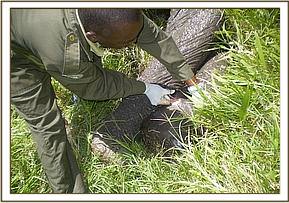
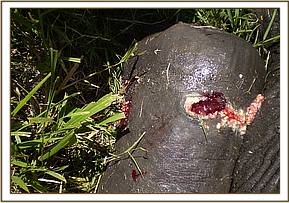

Prognosis
The animal had a favourable prognosis after the repeat treatment and since it was feeding well and had enough water nearby the recovery was anticipated soon. It was then revived from anaesthesia using 48mgs of Diprenorphine hydrochloride administered through the ear-vein and released to join the calf that was just nearby. There was also another herd of elephants nearby and it was likely to be a member of the herd. The rangers and the lodge manager were requested to keep monitoring the progress of the animal and report back to the veterinarian every often for attention.
Second case of elephant at Governors camp Masai Mara
This case was attended to on the same day as the above case, it involved a sub-adult male elephant that had a very tight snare wire on the left front limb just below the carpal joint. It had been treated one month ago but the wound had healed partially so there was a great need to repeat the treatment to enhance a quick recovery.
It was spotted at the middle of a swampy area and we had to move it to a dry ground before chemical restrain was attempted.
Chemical immobilization and capture
The elephant was then captured through darting using 15mgs of etorphine hydrochloride combined with 1500 i.u hyaluronidase. We used Dan-inject dart-gun propelled from about 20 meters away from the animal, the dart landed on the right thigh. It took about 6 minutes to become recumbent.
Physical examination and treatment
The wound was examined and found to be healing, the deep cut around the limb inflicted by a snare was filled up with granulomatous growths which was a very good sign of a healing process. It was then cleaned with water then debrided with 10% hydrogen peroxide and later treated with a tincture of iodine solution.

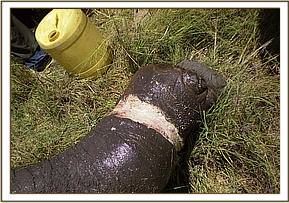
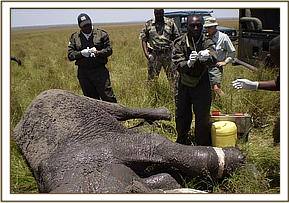

Other treatments included administration of long-acting (20%) oxytetracycline intramuscularly and multivitamins. The wound was also sprayed with oxytetracycline spray to keep off flies and enhance healing.
Prognosis
It had very good prognosis as the wound was healing well since the first treatment. The elephant was then revived from anaesthesia using 48mgs of Diprenorphine hydrochloride administered through the ear-vein. It joined the rest of the elephants nearby.
Euthanasia of a Croccodile at Simba Lodge Masai Mara
It was reported by the Warden-Mara that one of the crocodiles in Talek river next to Simba Lodge had an arrow sticking on the abdomen. The animal was in great pain and could not stay for long in water, it preferred lying in shallow water and it was easy to see the animal with the arrow. It was a sub-adult female crocodile. The veterinary team then went to the site to check on the condition of the animal and find ways of rescuing it.
The river was heavily infested with other crocodiles and hippos, this made it very difficult to use physical means to rescue the crocodile because of hippos that kept charging at whoever went near the river bank.
There were only two options of capturing the crocodile either by use of capture nets or darting using anaesthetics but both the methods had quite a substantial risks of animal getting drowned or capture team getting injured by other crocodiles and hippos. We then decided to put the animal to rest inorder to alleviate pain and suffering. 
The crocodile was later on pulled out of the river using ropes tied around the neck and abdomen, the arrow which was about 4 feet long, sharp on both ends and pierced through the abdominal viscera was then pulled out. The carcass was later transported on a pick-up and disposed off in a safe place away from people. This particular crocodile could have been mistaken as one of the stock-raiders and attacked by unknown people. Talek river from where it was found runs along the boundary of the game reserve and community lands and there are chances of human-wildlife conflict involving hippos and crocodiles in the river. 
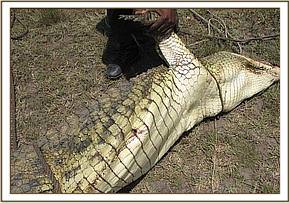

Rescue of an elephant calf from a water Dam in Lemek area
The calf was found by the area residents of Lemek while it was struggling to come out of the dam located at a GPS location S-01.06.647, E-035.25.511. The mother remained with it for a whole day and night, the KWS rangers from Narok were invited to come and help pull it out but the mother became very aggressive and kept charging at people and vehicles that went near the dam. Veterinary team from Mara was then called the following day to assist in rescuing the calf which was now getting exhausted from hunger and struggling. It was a female calf of about 9 months old and they belonged to a larger family of elephants which was said to within the vicinity.


Rescue operation
It was not possible to rescue the calf without restraining the mother which refused to move away despite making several attempts to scare it off. We then decided to anaesthetize the mother by darting so as to get a chance of rescuing the calf. The mother was then darted using 16mgs of etorphine hydrochloride combined with 1500 i.u of hyaluronidase. It became recumbent after about 5 minutes, it was then closely monitored to ensure that it was under a stable anaesthesia and dowsed with water to control its body temperature.


Meanwhile the calf was surrounded by ropes and pulled out by KWS rangers, veterinary team being assisted by the area residents, the calf was also making enough efforts to free itself. Eventually it came out of the pool after about 10 minutes of pulling. 
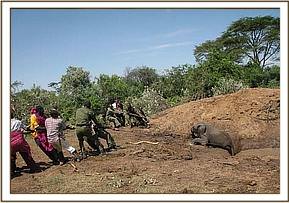

The mother was then revived from anaesthesia and left to join the calf, both the mother and the calf later joined each other in a nearby bush. The calf was still strong enough to survive because it was rescued at the right time.
De-collaring of an elephant bull in Ewaso-Nyiro Narok
This was one of the two elephants (Bull and a Matriarch) that were fitted with GPS collars in the year 2006. The collars were then used to track the elephants in their range-land and monitor their movement patterns for atleast two years. The data collected from the collars would then guide the elephant research scientists to make informed decisions and advise wildlife managers on how to control human-wildlife conflicts involving elephants which is common in Narok district. Nearly two years after fitting the collars to the elephants, there is need to remove the collars and retrieve the data for analysis.
De-collaring exercise
The exercise was carried out on 18/03/07, it was conducted by the veterinary team from Mara being assisted by research scientists from KWS headquarters and KWS staff from Narok station. The exercise was headed by the Senior Assistant director, Biodiversity Research and Monitoring division of KWS. Helicopter was used to track and spot the elephant before it was captured. After about 20 minutes of hovering, the collared bull was spotted in a company of another bull.
Chemical immobilization and capture of the elephant
The elephant was captured by chemical immobilization through darting using 18mgs of etorphine hydrochloride combined with 1500 i.u hyaluronidase. Darting was done by a helicopter which helped to move the animal to a fairly open ground for ease of manipulation. It took about 10 minutes to become recumbent, unfortunately it went down on sternal recumbency which could have a negative effect on respiration. Attempts to turn it to a lateral recumbency failed because the place was full of thorny bushes and lack of enough manpower to turn the elephant. So we decided to remove the collar in that position and release the animal within a short time as possible.
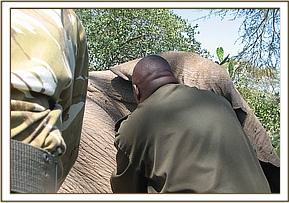

The collar was then removed using a pair of pliers and adjustable spanners. It was also treated with long-acting (20%) oxytetracycline antibiotic administered intramuscularly and eyes covered with Opticlox eye ointment.
Anaesthesia revival and release
After the removal of the collar, the elephant was then revived from anaesthesia using 60mgs of Diprenorphine hydrochloride through the superficial ear-veins. It took about 3 minutes to rise up from anaesthesia.
Search for the other elephant
The helicopter was then used for about one hour to search for the Matriarch which was also to be de-collared but it was not found that day. The exercise therefore came to an end for the time being. Resident scientist in Narok will search for the other elephant using a vehicle and if found will inform the veterinarian to come and assist in removing the collar.
Desnaring of a common zebra in Mara Triangle
This was a case of a female adult zebra that had a tight snare on the right hind limb and had inflicted injuries on the limb. The zebra was then captured by chemical immobilization through darting using 5mgs of etorphine hydrochloride combined with 70mgs of Xylazine hydrochloride. The animal became recumbent after about 6 minutes. The wire was then cut using a wire cutter and the animal revived from anaesthesia and released to join the rest of the herd. Prognosis was much favourable since the irritant wire had been removed. 
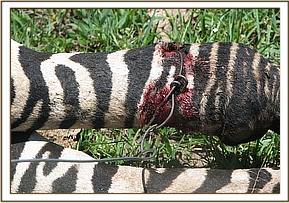

Investigation on deaths of various wildlife species in Soysambu ranch Nakuru
The ranch management reported to KWS offices in Nakuru that various antelope species particularly Elands had been dying sporadically over a period of time. It was then necessary to visit the farm and try to find out the cause of wildlife mortalities in the area. When the veterinary team arrived at the farm we were taken through the farm to survey some of the wildlife herds and see some old carcasses in the field.
Findings
The first carcass was that of a male Grant gazelle at a GPS location of S- 00.30.986, E- 036.11.241, the carcass had been preyed on and only skeletal tissues were found. This animal could have died of fight wounds probably while fighting for females. No any other case of grant gazelle death was found hence this was an isolated case not likely to be an infectious condition.
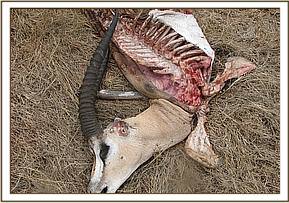

The second case was a one day old carcass of an adult waterbuck. When the carcass was closely examined it had a penetrating wound ventral to the right eye breaking one of the upper premolar teeth. It is suspected to have developed septiceamia due to wound infection which resulted to death. It was found just a few kilometers from Lake Elmentaita at a GPS location S-00.24.513, E- 036.13.110.
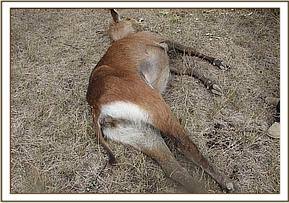

The third case was that of two buffalo calves of about 2 months old, the carcasses were found at the lake shore and had been preyed on by predators. The calves were suspected to have died of water poisoning (water intoxication) which is very common in calves especially if there has been much loss of salt due to severe exercise or high environmental temperatures. It leads to severe haemolytic anaemia and haemoglobinuria that can lead to death of calves. Water intoxication does not occur commonly and can be avoided by allowing thirsty animals to have only a limited access to water. These animals were found at a GPS location of S- 00.25.109, E- 036.12.803. 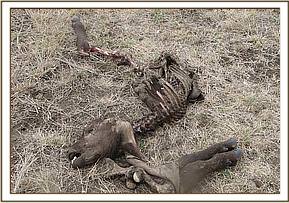
The ranch manager was requested to keep monitoring all the wildlife species in that ranch and report the progress of animals’ health to the veterinarian for quick action.
BLAC
K RHINO (Diceros bicornis) EAR-NOTCHING IN LAKE NAKURU NATIONAL PARK.Introduction
The Black rhino ear-notching in Lake Nakuru National park began on 25th March, 2008, the KWS has a key mandate to conserve and manage this key and endangered species and it is for this reason that the KWS rhino programme in conjunction with the veterinary department are working on an intensive countrywide rhino ear-notching. The target is to ear-notch about 60% of black rhino population in the country.

Ear-notching in rhinos is meant to assist rhino monitoring team in accurate identification of individuals and daily follow up. A total of 21 black rhinos were captured and ear notched in Lake Nakuru within three working days.
Chemical immobilization and capture
Darting of all the rhinos was done from a Helicopter using a Palmer Cap-Chur dart gun. Adult rhinos were immobilized using 5mgs of etorphine hydrochloride combined with 100mgs of Xylazine hydrochloride and 1500 i.u hyaluronidase while sub-adult rhinos were immobilized using 3.5mgs of etorphine hydrochloride combined with 60mgs of Xylazine hydrochloride and 1000 i.u hyaluronidase. Once a rhino was darted and it became recumbent the veterinary team on the ground would ensure that the animal is under stable anaesthesia by taking not of vital physiological parameters such as respiration, heart rate, body temperature, capillary refill time of the mucosal surfaces among others. About 5mgs of Nalorphine hydrobromide was administered immediately the rhino was down to improve the respiration. Eyes were covered using a blind-fold and water poured to the animal to help control the body temperature.
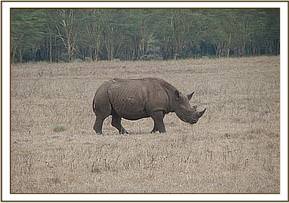
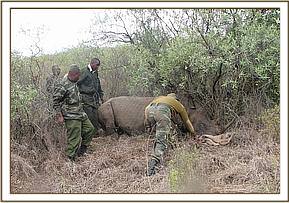

The animal was then ear-notched with a predetermined notch pattern, then biological samples such as tissue, blood, feacal and skin scrapings collected and preserved for analysis. Other treatments to the rhinos included administration of antibiotics, eye ointments, ecto-pour for ectoparasites and antibiotic spray of the ear-notch wounds.


Anaesthesia revival
After the process of notching the animal was complete everyone moved away except for the veterinarian who was to revive the rhino. All the rhinos were revived using 24mgs of Diprenorphine hydrochloride combined with 10mgs of Atipamezole hydrochloride administered through the superficial vein and 12mgs of Diprenorphine administered intramuscularly. If the animal still appeared drowsy then 50 – 100mgs of Naltrexon was administered intramuscularly.
The ear-notching exercise went on smoothly and a total of 21 black rhinos were successfully notched in 3 days.
Conclusion
The veterinary activities are going on successfully in Masai Mara and other parts of Central Rift region. Basic laboratory equipment and laboratory technician are required to help improve the veterinary services and research activities in the region. Other constraints are lack of internet access and a refrigerator for storing biological samples for diseases diagnosis and research activities in Mara research station.
Reported by: Dr. Dominic Mijele